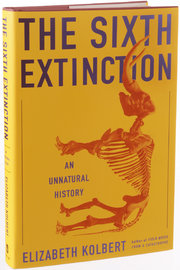By Mike Weilbacher, Executive Director
Book review for the Philadelphia Inquirer, a print version of this review appeared in the Philadelphia Inquirer on Sunday, March 30, 2014.
 We inhabit an extraordinary planet overflowing with an abundance of life: massive coral reefs built by billions of tiny invertebrates, rain forests teeming with uncountable plants and animals, frogs and toads singing in vernal ponds, bats flitting over summer meadows.
We inhabit an extraordinary planet overflowing with an abundance of life: massive coral reefs built by billions of tiny invertebrates, rain forests teeming with uncountable plants and animals, frogs and toads singing in vernal ponds, bats flitting over summer meadows.
But we also live at an extraordinary moment when all of the creatures named above, and millions more, might disappear in our lifetime. And while climate change gets all the attention as an environmental game-changer, the loss of biological diversity, the burning of the Tree of Life, has too quietly slipped below the cultural radar screen.
Until now. Elizabeth Kolbert, staff writer for the New Yorker and author of the acclaimed Field Notes From a Catastrophe about climate change, has just published the definitive book on the biodiversity crisis. It is a must-read for every citizen of this planet.
As a science writer and reporter, Kolbert has few peers. Just as she did so effectively in Field Notes, Kolbert travels to the front lines of the issue, visiting the biodiversity hotspots you might expect, such as the Amazon rain forest and Australia’s Great Barrier Reef. But she also mixes in a ton of surprises, and much of the joy of the book is discovering where she ends up next: an Icelandic museum to visit a stuffed great auk, the last of which vanished in the 1840s, or the “Frozen Zoo,” a California lab that cryogenically stores cells from nearly a thousand species of extinct and nearly extinct species.[pullquote]The language of the Earth is losing nouns, names being plucked from the landscape: little brown bat, golden toad, Sumatran rhinoceros, Guam rail.[/pullquote]
Kolbert begins in Panama, where she walks alongside scientists frantically searching for vanishing frogs, too quickly succumbing to a little-understood fungus. Frogs are amphibians, a group that “enjoy[s] the dubious distinction of being the world’s most endangered class of animals.” While creatures have always vanished throughout geological history, the natural extinction rate is incredibly small; amphibians, Kolbert reports, are now disappearing at a rate 45,000 times higher than normal.
The book also travels through the human understanding of extinction; these early chapters alone are worth the price of admission. She traces the history of extinction itself, the title alluding to five previous, natural, very large extinction events. The last big extinction occurred when that now-famous asteroid smashed into the Yucatan peninsula 65 million years ago, wiping out T. rex and maybe two-thirds of all life on Earth; she walks us through the science that painstakingly led to the theory, then covers the ensuing debate.
How bad is the sixth extinction? “It is estimated,” she observes, “that one-third of all reef-building corals, a third of all freshwater mollusks, a third of all sharks and rays, a quarter of all mammals, a fifth of all reptiles, and a sixth of all birds are headed toward oblivion.” That bad.
While extinction is natural, her book’s subtitle signals her impatience with anyone declaring the sixth extinction “natural.” Never before has one species so rearranged the planet, or so greatly altered the planet’s chemistry and biology, that so many creatures could die out. “This time,” one scientist says ominously, “we are the asteroid.”
The toughest part of the book is its last two chapters, where she visits not only the Frozen Zoo, but also the Neander Valley in Germany to see where fossils of our cave cousins – a separate human species that once lived alongside us – were discovered in 1856. Turns out that Homo sapiens likely killed off Neanderthals while, at the same time, intermingling with them (lots of us still carry Neanderthal genes). But “man the wise,” as our Latin name translates, seems to have been foolishly killing off life from Day 1. From Ice Age mastodons 10,000 years ago to flightless moas in New Zealand killed off in the 1400s, extinction has trailed in our wake for millennia.
We are burning tropical rain forests, poaching animals such as elephants and rhinos beyond their capacity to recover, and introducing invasive species everywhere (10,000 different species carried in ship ballast every single day worldwide). But the sixth extinction also has more subtle causes: Overheating the atmosphere with carbon dioxide changes land habitats, but also affects oceans, now acidifying from the excess carbon. Acidifying oceans are killing off coral – and possibly one-third of all ocean life as it does. The sixth extinction has multiple causes, but we are at the root of each.
Her last chapter, titled “The Thing with Feathers,” alludes to Emily Dickinson’s famous poem about hope, and she struggles to end on a hopeful note. “Though it might be nice to imagine there was once a time when man lived in harmony with nature,” she concludes “it’s not clear that he ever really did.”
Our “enduring legacy,” she ends, will be the sixth extinction.
The language of the Earth is losing nouns, names being plucked from the landscape: little brown bat, golden toad, Sumatran rhinoceros, Guam rail. While the book is not intended as a call to action, I hope its readers will rally around the burning Tree of Life, and agree that the preservation of this language is our highest calling, the necessary work of our time.
